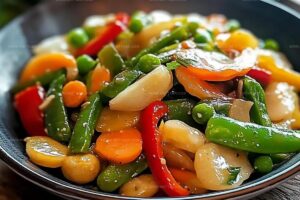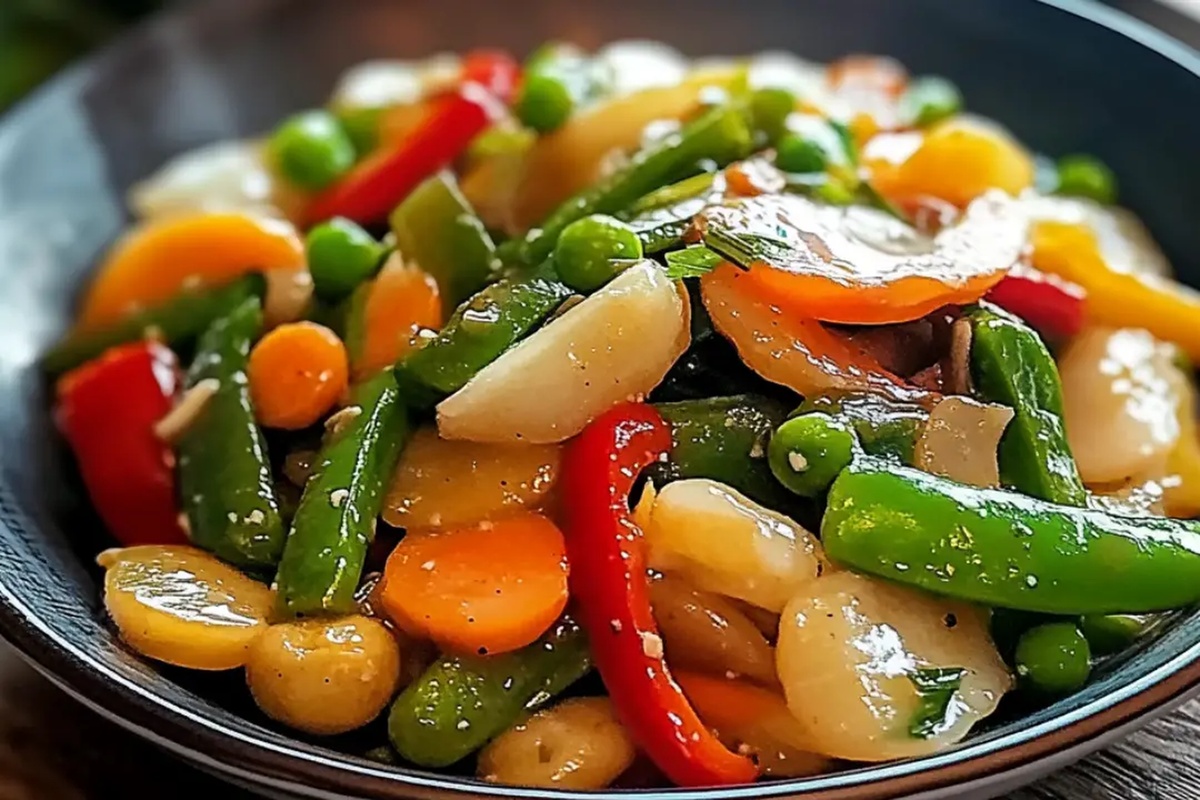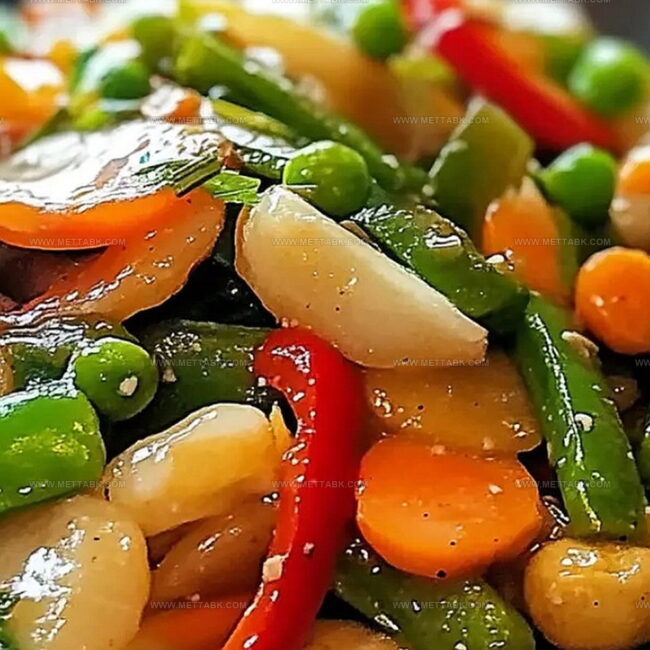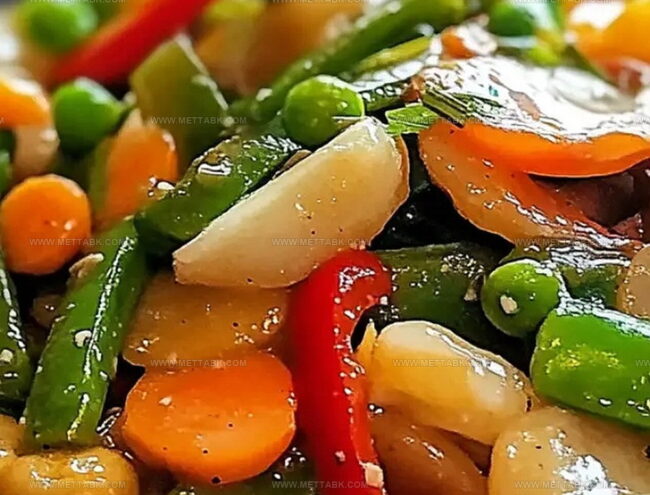Dreamy Stir-Fried Veggies In White Sauce Recipe For Tonight
Crafting a delightful stir-fried veggies in white sauce feels like painting a culinary masterpiece with vibrant ingredients.
Colorful vegetables dance together in a creamy, velvety embrace that promises comfort and excitement.
Crisp bell peppers, tender broccoli, and sweet carrots create a symphony of flavors waiting to burst onto your plate.
Weeknight dinners become extraordinary when you transform simple produce into something magical and unexpected.
Our secret weapon?
A luxurious white sauce that hugs each vegetable with silky smoothness.
Subtle herbs and a whisper of garlic elevate this dish from ordinary to extraordinary.
Hungry diners will absolutely fall in love with this quick, nutritious meal that comes together in mere minutes.
Stir-Fried Veggies in White Sauce That Satisfy Cravings
Ingredients for Stir-Fried Veggies in White Sauce
For the Proteins:For the Core Vegetables:For the Aromatics:For the Sauce Ingredients:For the Thickening and Seasoning:For the Cooking:How to Cook Stir-Fried Veggies Perfectly
Step 1: Chop and Prepare Vegetables
Slice cabbage, broccoli, and carrots into bite-sized pieces. Arrange neatly on a cutting board and set aside.
Peel and mince fresh garlic and ginger for extra flavor punch.
Step 2: Create Magical Sauce
Gather sauce ingredients:Whisk all ingredients in a bowl until perfectly blended.
Let the mixture rest while preparing other components.
Step 3: Season Succulent Shrimp
Mix shrimp with:Gently coat each shrimp, ensuring even distribution of seasonings.
Step 4: Blanch Vibrant Vegetables
Fill a large pot with water and bring to a rolling boil. Quickly submerge cabbage, broccoli, and carrots for 30-45 seconds.
Immediately transfer vegetables to an ice bath to halt cooking and preserve crisp texture. Drain thoroughly.
Step 5: Sizzle and Sear Shrimp
Heat cooking oil in a large wok or skillet. Toss in minced garlic and ginger, stirring rapidly until aromatic.
Add seasoned shrimp and cook until they turn pink and slightly curled.
Step 6: Pour and Boil Sauce
Stream prepared sauce into the wok.
Allow mixture to bubble and simmer, coating shrimp with rich flavors.
Step 7: Thicken the Sauce
Create a smooth cornstarch slurry and slowly stir into the simmering sauce.
Watch as the liquid transforms into a luxurious, glossy coating.
Step 8: Combine Vegetables and Protein
Gently fold blanched vegetables into the shrimp and sauce.
Ensure every piece gets evenly coated with the delectable sauce.
Step 9: Final Flourish
Drizzle with sesame oil for an authentic touch.
Give a final gentle toss and transfer to serving plates. Enjoy your restaurant-quality meal!
Tips to Bring Out the Best Flavors
Variations to Change Up Your Stir-Fry
Pairing Ideas That Complement Stir-Fried Veggies
Storing Stir-Fried Veggies for Freshness
Transfer leftovers to an airtight container and store in the refrigerator for up to 3 days. Keep sauce and vegetables separate to maintain texture.
Cool completely, place in freezer-safe containers, and freeze for maximum 2 months. Separate shrimp and vegetables to prevent sogginess.
Place portions on microwave-safe plate, sprinkle few drops of water, cover with damp paper towel, and heat in 30-second intervals until warm. Stir between intervals to distribute heat evenly.
Warm in a skillet over medium-low heat, adding splash of chicken broth to restore moisture. Gently stir to prevent breaking vegetables and maintain original texture.
FAQs
Blanching helps preserve the vegetables’ bright colors, removes excess dirt, and partially cooks them, ensuring they stay crisp and tender during the final stir-frying process.
Baking soda helps tenderize the shrimp by breaking down the protein, making them more plump, juicy, and preventing them from becoming tough during cooking.
If Shaoxing wine is unavailable, you can replace it with dry sherry or rice wine. White wine can also work, though the flavor profile will be slightly different.
Print
Stir-Fried Veggies In White Sauce Recipe
- Total Time: 20 minutes
- Yield: 4 1x
Description
Creamy white sauce envelops crisp stir-fried vegetables in this delightful culinary journey through comfort and flavor. Fresh ingredients and simple techniques combine to create a quick, satisfying meal that brings warmth to your dinner table.
Ingredients
Main Proteins:
- 1 pound (1 lb) shrimp, peeled and deveined
Vegetables:
- 3 cups cabbage, cut into 2–3 inch pieces
- 1 head broccoli, cut into bite-sized pieces
- 2 small carrots, peeled and cut into 1–8 inch pieces
- 5 garlic cloves, finely minced
- 1/2 teaspoon (1/2 tsp) ginger, grated or finely minced
Sauce and Seasoning Ingredients:
- 1 1/2 cups low sodium chicken broth
- 2 tablespoons (2 tbsp) shaoxing wine or mirin
- 1 teaspoon (1 tsp) kosher salt
- 1 teaspoon (1 tsp) sugar
- 1 teaspoon (1 tsp) chicken bouillon
- 1 teaspoon (1 tsp) cornstarch
- 1/2 teaspoon (1/2 tsp) white or black pepper
- 1/8 teaspoon (1/8 tsp) baking soda
Slurry and Oils:
- 1 tablespoon (1 tbsp) cornstarch
- 2 tablespoons (2 tbsp) water
- Cooking oil (avocado oil recommended)
- 1 teaspoon (1 tsp) sesame oil (optional)
Instructions
- Carefully wash and chop all vegetables into uniform bite-sized pieces to ensure even cooking and consistent texture.
- Create the white sauce by whisking chicken broth, shaoxing wine, salt, sugar, and chicken bouillon in a small mixing bowl until ingredients are completely integrated.
- Prepare shrimp by gently coating with cornstarch, salt, pepper, and baking soda, ensuring each piece is evenly seasoned and protected.
- Rapidly boil water in a large pot and quickly submerge cabbage, broccoli, and carrots for 30-45 seconds. Immediately transfer vegetables to ice water to halt cooking process and preserve vibrant colors and crisp texture.
- Heat cooking oil in a wok over high temperature around 375°F. Sauté minced garlic and ginger for 15 seconds until aromatic, releasing their essential oils.
- Add marinated shrimp to the hot wok, cooking for 1-2 minutes until they turn opaque and develop a light golden exterior.
- Pour prepared sauce into the wok, allowing liquid to reach a rolling boil and thoroughly coat the shrimp.
- Create a cornstarch slurry and gently stir into the sauce, watching it thicken and become glossy within 30 seconds.
- Incorporate blanched vegetables into the wok, tossing everything together to distribute heat and flavors evenly.
- Finish the dish with a delicate drizzle of sesame oil, providing a nutty fragrance, and serve immediately while piping hot.
Notes
- Quickly blanch vegetables to maintain their vibrant color, crisp texture, and lock in nutrients without overcooking.
- Toss shrimp in cornstarch and baking soda for an extra tender, restaurant-style texture that prevents rubbery consistency.
- Adjust the sauce’s sweetness and saltiness by gradually adding seasonings, tasting as you go to achieve perfect flavor harmony.
- Swap shrimp with tofu for a vegetarian version, or use gluten-free tamari instead of chicken broth for a gluten-sensitive diet.
- Prep Time: 15 minutes
- Cook Time: 5 minutes
- Category: Lunch, Dinner, Appetizer, Snacks
- Method: Sautéing
- Cuisine: Chinese
Nutrition
- Serving Size: 4
- Calories: 140 kcal
- Sugar: 1 g
- Sodium: 800 mg
- Fat: 4 g
- Saturated Fat: 0.5 g
- Unsaturated Fat: 3 g
- Trans Fat: 0 g
- Carbohydrates: 8 g
- Fiber: 2 g
- Protein: 18 g
- Cholesterol: 125 mg





Nate Harper
Founder & Recipe Curator
Expertise
Single-Recipe Development, Farm-to-Table Cooking, Seasonal Menu Planning, Culinary Storytelling, Home Kitchen Innovation
Education
Cascade Culinary Institute – Central Oregon Community College
Certificate in Culinary Arts
Focus: Farm-to-table cuisine, sustainable cooking practices, and seasonal recipe creation.
Nate studied under experienced chefs who emphasized local sourcing, minimal waste, and building recipes from fresh, simple ingredients.
Nate Harper is the founder and creative force behind Make, Take, Bake. Raised in the wild beauty of Oregon’s high desert, Nate grew up surrounded by family gardens, farmers’ markets, and home kitchens that celebrated the seasons.
His early love for simple, honest food evolved into a professional passion when he attended Cascade Culinary Institute, where he sharpened his skills in creating recipes that are sustainable, satisfying, and made for everyday life.
Nate’s goal is to make cooking feel accessible, free of fuss, and full of flavor. He believes a single, thoughtfully built dish can stand alone, and sometimes even steal the show.